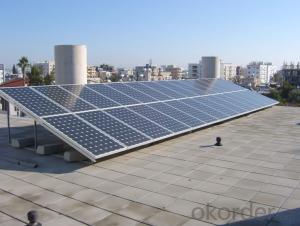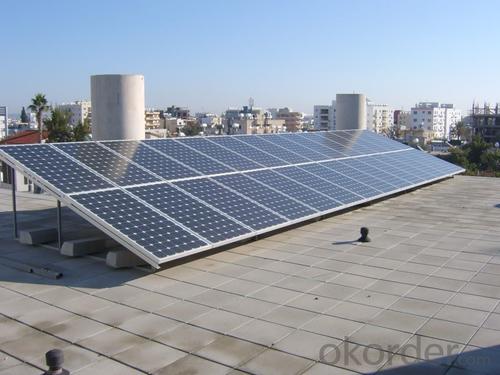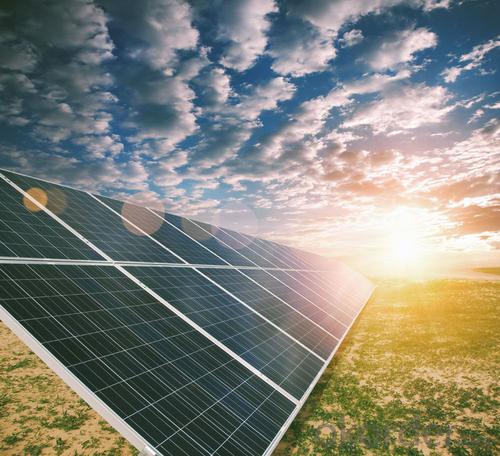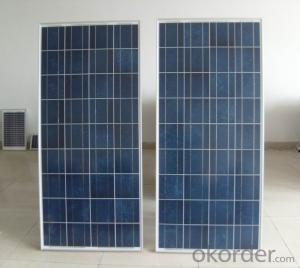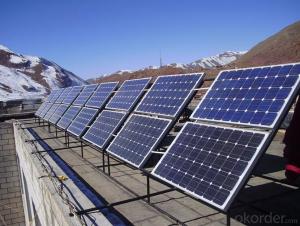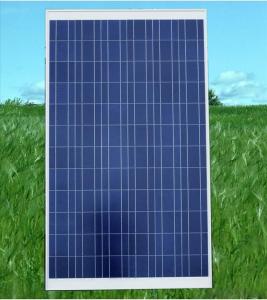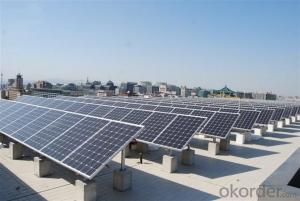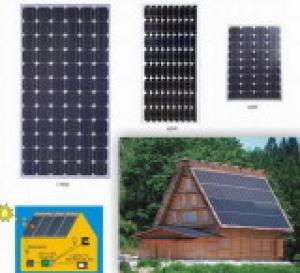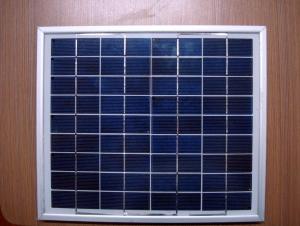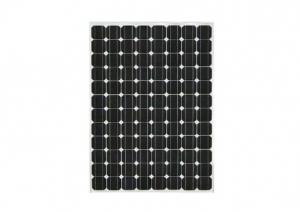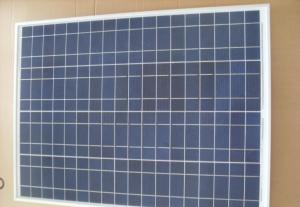Plastic Polycrystalline Silicon Solar Panels 255W
- Loading Port:
- Nanjing
- Payment Terms:
- TT OR LC
- Min Order Qty:
- 200000 watt
- Supply Capability:
- 20000000 watt/month
OKorder Service Pledge
OKorder Financial Service
You Might Also Like
INTRODUCTION
This installation Manual contains essential information for the electrical and mechanical installation that your must know before installing CUSTOMER PV modules. This also contains safety information you need to be familiar with .All the information described in this manual are the intellectual property of CNBM and based on the technologies and experiences that have been acquired and accumulated in the long history of CUSTOMER. This document does not constitute a warranty, expressed or implied.
CUSTOMER does not assume responsibility and expressly disclaims liability for loss, damage, or expense arising out of in anyway connected with installation, operation, use or maintenance of the PV modules. No responsibility is assumed by CUSTOMER for any infringement of patents or other rights of third parties that may result from use of PV module.
CUSTOMER reserves the right to make changes to the product, specifications or installation manual without prior notice.
Standard Test Conditions of Polycrystalline Silicon Solar Panel
The opto-electrical specifications shown below are stabilized values being measured at Standard Test Conditions of multicrystalline silicon Solar Panel, Irradiance: 1000W/m2, Spectrum: AM1.5 at 25°C, The info below is subject to manufacturing tolerances. Where appropriate minutes of measurement are available and are used for the dimensioning of the installation.
Advantages of Polycrystalline Silicon Solar Panel
A&M Solar performance guarantees for 25 years
12 years guarantee for workmanship for multicrystalline silicon Solar Panel
Timeliness of delivery
Quality Products certified (TÜV, UL, CE, VDE, ISO)
WORK PRINCIPLE

SITE SELECTION
In most applications, the PV modules should be installed in location where there is no shading throughout the year. In the Northern Hemisphere, The PV modules should typically face south, and in the Southern Hemisphere, the PV modules should typically face north. Please make sure that there are no obstruction in the surroundings of the site of installation. Take proper steps in order to maintain reliability and safety, in case the PV modules are used in areas such as: Heavy snow areas/Extremely code areas/ Strong wind areas/Installation over, or near, water/ Areas where installations are prone to salt water damage (*)/Small islands or desert areas.(*)
If you are planning to use the PV modules where the salt water damage may be possible consult with CNBM local agent first to determine an appropriate installation method, or to determine whether the installation is possible?
DATA SHEET
Maximum Power | 255W |
Efficiency | 0.157 |
Backsheet | White |
Frame Colar | Silver |
Manufacture Site | China |
Frame | Anodized Aluminum Alloy |
Weight | 19 kg |
- Q: I know that one LED can't power a solar panel. I have found 40 kmcd LED's on OKorder. I know that several of them (28 totale each one with a 470 ohm resistor all at 2 VDC) can show a reflection on a wall in daylight 60 feet away..
- The 40 kmcd rating is a measure of luminous intensity (how bright it looks), not a measure of output power of the visible light. We can estimate the performance of your proposed system as follows: The LEDs on OKorder each are rated about 20mA maximum at about 3.2V, or 64mW (milliwatts). If you use 470 ohm resistors connected to 2VDC, the current that will flow, per LED, will be about: (2V-3.2V)/470ohm = 0.0872A = 8.72mA The power taken from the 2VDC power source will be: P2v = 2V x 8.72mA = 224.6mW (per LED) The power input to each LED will be about: Pled = 3.2V x 8.72mA = 59.9mW (per LED) The LED has a luminous efficiency that can range from about 4.2% to 22%. This efficiency is the ratio of the amount of visible light output (in watts) divided by the input power (in watts). The OKorder listing doesn't identify the output power level (either in watts or in lumens), so let's assume a 0% efficiency. The LED output power will be about: Pout = 59.9mW x 0% = 5.99mW (per LED) A solar panel converts visible light to electrical energy with an efficiency that ranges say about 6% to 8%. Suppose the solar panel efficiency is 2%. Then the electrical power output by the panel will be about : Pe = 5.99mW x 2% = 0.72mW (per LED) If you shine 00 LEDs on the panel, the output electrical power will be 00 times that amount: Pe00 = 0.72mW/LED x 00 LED = 72mW <===ANSWER The power taken from your 2V source will be about: P2V00 = 224.6mW/LED x 00 LED = 22460mW = 22.46W The system efficiency will be about: Eff = solar output / battery input = Pe00 / P2V00 = 72mW / 22460mW x 00% = 0.32% SUMMARY: If you shine 00 of the LEDs on the panel, you will capture back about 0.32% of the energy expended, or regain about 72mW.
- Q: Can solar panels be used for powering a research facility or laboratory?
- Yes, solar panels can be used to power a research facility or laboratory. Solar panels convert sunlight into electricity, providing a sustainable and renewable source of power. By harnessing solar energy, research facilities and laboratories can reduce their reliance on traditional energy sources and contribute to a greener and more environmentally friendly operation. Additionally, solar panels can be integrated into the existing infrastructure of the facility, making them a viable option for powering various scientific equipment and systems.
- Q: Can solar panels be installed on a greenhouse?
- Yes, solar panels can be installed on a greenhouse. In fact, it is a common practice to install solar panels on greenhouses to harness solar energy for both power generation and to provide supplemental lighting and heating for the plants inside.
- Q: I just bought a quot;00 wattsolar panel system to install on my house. I just wanted to know if by 00 watts, does that mean per hour, min, day week or what?
- It means that it will deliver 00 watts of energy. Assuming correct voltages, etc. you could connect a 00W incandescent lamp and it will work just fine. So it is the instantaneous output of the panel. Storage is more typically measured in the watt/hour manner - identifying capacity rather than immediate availability. If you have 000 watt/hours of stored energy then you can run your 00W lamp for 0 hours - or two 00W lamps for 5 hours. See? It's simple.
- Q: I am in the market for buying a home. There is one for salke that actually has solar panels on top. How are they used? Do you need to pay for gas and electric still. Does it really light up the house and keep it warm. WHat about the AC keeping hte house cool in the summer does it work for that too? Please explain in solar for dummy terms. I haveno clue about solar panels other thatn the fact that it needs sunlight to run.
- Okay--here it is (without the techie buzzwords!) Solar power has a start up cost--the panels and related equipment. But the amount it cost to operate is virtually zero--pretty much jsut servicing th equipment o keep it working properly--much as you do any other appliance. How much electricity you will still have to buy depends on four things: a) how much your system can produce. If you have a 4000 watt system, you'll still buy a fair amount of power. Abigger one--and you will need less from the power company b) how efficient you (your home and appliances are). The more efficient, the less electricity you use. Obviously, things lie CFL bulbs are very helpful here c) Are you willing to invest in a battery storage system to store electricity from the system for use at night? Right now, that's still pricey. But these are starting to come on th emarket more. If you aren't ready to do tha tnow, you can always add it in later. d) can you sell excess power back to the power company.? In California, the law requires utilities to do this--but its not a universal yet, so it depends on where you are. How this works: you are still hooked up to the power company. Any time you need more power than the solar system produces, yur system jst draws it off the power grid--jsut as always. But--any time you are using LESS than the amount of power your system is producing, the excess automatically feeeds back into the electric grid and a special peter credits you with the power. There are cases wwhere people have goene on a long vacation in California and when they got home, the power company owed them several hundred dollars! You'll need to do some research, price thngs, take your own lifestyle into account, and decide what the best choices for you are. It sounds complicated--and to an extent it is. But the reason is tha tyou have a lot of choices tha tyou can make work to your advantage, instead of jsut writing a fat check to the power company every month!
- Q: Can solar panels be used in areas with high humidity or saltwater exposure?
- Yes, solar panels can be used in areas with high humidity or saltwater exposure. However, the performance and longevity of the panels may be affected by these environmental factors. It is important to choose solar panels specifically designed for such conditions and regularly maintain and clean them to ensure optimal efficiency.
- Q: Can solar panels be installed on a hotel or hospitality facility?
- Yes, solar panels can be installed on a hotel or hospitality facility. In fact, many hotels and hospitality facilities are adopting solar energy as a sustainable and cost-effective solution. Solar panels can be installed on the rooftops, parking lots, or any available open space to generate clean and renewable energy for the facility's electricity needs. This not only reduces the carbon footprint but also helps in saving on energy bills in the long run.
- Q: i am trying to get it to work on solar power They are outdoors and we dont feel like running a few hundred feet of power cables. Thanks and best answer will get 0 points.
- Research using solar panels on stock tank water pumps. Same concept - you use a solar panel to power a remote something or other, only you would have to use a battery charged by day to run the camera at night. It does not look like you would need too powerful of a solar panel, the camera server says it needs less than 5w, no idea on the cameras, so check that out, but the whole system looks rather low power. You could easily get the necessary panels, maybe the battery too, for... I would say $200 (not in one package, you would have to get separate things). Connection of everything would be simple, no electrician needed (but keep that to yourself, depending upon state rules and regs).
- Q: I'm looking into buying solar panels, there are all kinds of ranges of energy output...but my question is, when ti says...say 50 watts of power...does that mean 50 watts a day, an hour, a minute, what?
- A 50-watt rating means the panel will produce 50 watts as long as the standard conditions are maintained. So if you had this bright sun and cool temperatures for 6 hours, the panel would deliver 50 x 6 = 900 watt hours, or a little shy of kilowatt-hour. Kilowatt-hours (kWh) is the reading on your electric bill. However, like most advertising, the 50-watt number is not realistic. They assume that the air surrounding the panel is very cold. 25 watts is a better number to use for this size of panel for engineering purposes.
- Q: I am heading to Nepal and do not want to lose power on my cameras but they can only be charged via quot;plugging inquot;. A USB connection does not work. Looking for a solar panel to clip to my bag or carry that I can plug in the charger as if plugging in to wall outlet. Thanks.
- Solar panels require a charge converter before it can be used by an AC source. There is no direct solar panel with built in charge converters that I know of because, when purchasing panels, you must purchase the wattage requirements of the job (this can be several panels linked), and a charge converter that will handle the <? panels required. A chain of stores up here in Canada have a portable battery pack that has a solar panel to increase its charge capacity or duration, but its not something you would want to lug around for long periods of time, because is weights in about 3 lbs.
Send your message to us
Plastic Polycrystalline Silicon Solar Panels 255W
- Loading Port:
- Nanjing
- Payment Terms:
- TT OR LC
- Min Order Qty:
- 200000 watt
- Supply Capability:
- 20000000 watt/month
OKorder Service Pledge
OKorder Financial Service
Similar products
Hot products
Hot Searches
Related keywords
